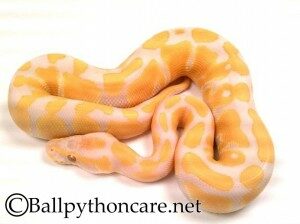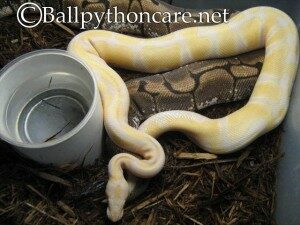Albino ball pythons are a single gene base morph mutation that is inherited in a simple recessive fashion. That means you must have two copies of the gene in order for it to be displayed, so all albinos are actually carrying two copies of the gene for albinism. That being said, if you breed an albino to a normal ball python then all of the offspring with look normal, but will carry one copy of the gene for albinism aka albino. If you happen to breed those offspring together you have a 25% chance at producing an albino out of four eggs. All in all, pretty simple stuff.
As far as physical appearance goes albinos are show stoppers, what I mean by that is everyone loves an albino because they are so drastically different from the normal wild type ball python. Contrary to popular belief they don’t lack all color pigment, they only lack black and brown which leaves you an animal that is mainly just orange, yellow and white with red eyes.
Background and History of the mutation
The albino ball python is pretty much the granddaddy of all the ball python morphs. I remember looking through Reptiles Magazine back in the mid 90’s and seeing ads for albino ball pythons by Bob Clark. I remember thinking how awesome it would be to own such a sought after animal. You see at that time in the game these guys were going for $25,000 dollars apiece. Just to get normal looking animals that carried the albino gene (which is also known as heterozygous) was $10,000 dollars for a male and female pair. At that time there really wasn’t much of a ball python morph game, that wouldn’t really pick up for another 4-5 years after the albinos came to market.
Clark. I remember thinking how awesome it would be to own such a sought after animal. You see at that time in the game these guys were going for $25,000 dollars apiece. Just to get normal looking animals that carried the albino gene (which is also known as heterozygous) was $10,000 dollars for a male and female pair. At that time there really wasn’t much of a ball python morph game, that wouldn’t really pick up for another 4-5 years after the albinos came to market.
Odd behaviors or occurrences with the gene
Please keep in mind when you read this section about odd behaviors or occurrences it’s just my opinion based on my experience working with the gene in discussion. From my limited experience working albinos I’ll say that my animals didn’t seem to be the best feeders. Now that could be due to some other factor in my little micro environment, but my animals didn’t really seem like a good thriving group. I had the same experience with my heterozygous animals as I did with my homozygous animals. Talking with other breeders, I heard another common complaint which was the females didn’t seem to be the best producers either. Of course, that’s just hear say, but in my personal opinion this gene doesn’t seem to be the strongest gene out there, but like I said, take that with a grain of salt because of my limited experience working a small group.
Combination potential
This gene has pretty much seen its combination potential played out through several albino combo animals which have been produced over the years. All in all, I’d give the albino ball python a score of 4 out of 10 when it comes to combinations simply because the other variations of the gene like the lavender and toffee have proven to make for the preferred combo gene. The regular albino is an awesome base morph all by itself, but if you’re looking for the next cutting edge combo maker I’d go with something more along the lines of the lavender albino.
Current market status
The current market status is thriving at the pet store and beginner private ball python breeder level for this gene.  Although, albinos once sold for 25k just about 20 years ago today the price is pretty steady at a couple hundred bucks, but at that price they are selling extreme well in large numbers at the pet store level. We have seen an increase in price and demand for adult albino females since the discovery that the toffee ball python is compatible with the albino ball python was made public last year. With that news hitting the market there have been droves of breeders willing to pay pretty decent money for adult females in hopes of producing the toffee/albino cross also known as the toffino. Another progression that has helped keep the market stable for this gene is that a lot of smaller private breeders have quit working with the gene to pursue more profitable genes, leaving a small void in supply. On the other hand the larger commercial breeders are probably filling that void easily as they produce hundreds of albinos on a massive scale for the pet trade.
Although, albinos once sold for 25k just about 20 years ago today the price is pretty steady at a couple hundred bucks, but at that price they are selling extreme well in large numbers at the pet store level. We have seen an increase in price and demand for adult albino females since the discovery that the toffee ball python is compatible with the albino ball python was made public last year. With that news hitting the market there have been droves of breeders willing to pay pretty decent money for adult females in hopes of producing the toffee/albino cross also known as the toffino. Another progression that has helped keep the market stable for this gene is that a lot of smaller private breeders have quit working with the gene to pursue more profitable genes, leaving a small void in supply. On the other hand the larger commercial breeders are probably filling that void easily as they produce hundreds of albinos on a massive scale for the pet trade.